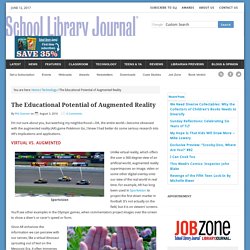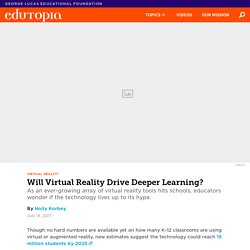

Skype, Hangouts and TEACH MEET. The Educational Potential of Augmented Reality. I’m not sure about you, but watching my neighborhood—OK, the entire world—become obsessed with the augmented reality (AR) game Pokémon Go, I knew I had better do some serious research into AR’s implications and applications.

Virtual vs. augmented Sportvision Unlike virtual reality, which offers the user a 360-degree view of an artificial world, augmented reality superimposes an image, video or some other digital overlay onto our view of the real world in real time. For example, AR has long been used in Sportvision to project the first down marker in football.
It’s not actually on the field, but it is on viewers’ screens. Magic Leap Since AR enhances the information we can perceive with our senses, like a virtual dinosaur sprouting out of text on the Mesozoic Era, it often immerses users into the experience in a way that makes learning more meaningful. Potential applications of AR Imagine this: a librarian creates AR for a book display. Arloon. Will Virtual Reality Drive Deeper Learning? Though no hard numbers are available yet on how many K–12 classrooms are using virtual or augmented reality, new estimates suggest the technology could reach 15 million students by 2025.

But without research to show the impact, experiences like landing on the moon or the sinking of the Titanic could be closer to entertainment than education, argue critics, who say much of what’s being marketed as virtual reality is not groundbreaking—or even new. Computer scientists first began experimenting with “virtual experiences” in the 1950s, and by the 1980s goggles and gloves had been developed to simulate immersion in a virtual world. “My question is always: How is virtual reality different from educational film?” Asks Audrey Watters, who speaks extensively on the role of technology in education and writes the blog Hack Education. ©Shutterstock.com/Piotr Adamowicz Because of its simple design, Google Cardboard can be used with most smartphones. There’s also the price tag.
Bringing Science to Life. Virtual Field Trips. 20 Uses For Virtual Worlds In The Classroom. Editor’s Note: This is part two of Using Virtual Worlds to educate.

You can find part 1 here. You probably never thought you could attend a virtual lecture, discussion, exam, or lab in 3D. In fact, this is already possible. Virtual worlds have clear advantages over traditional classroom settings. I once had to teach high school students the importance of safety precautions for a welding class. I delved a bit further into the uses of virtual worlds and even created an avatar of my own (PiJustice) to see the current applications of virtual worlds in education. Here is what I found: Virtual worlds are emerging as a meeting place for the most prestigious universities, non-profits, and academic institutions in the world. Their uses are varied and can adapt to different needs. Discovery Education Virtual Field Trips: Careers. Virtual Field Trip Apps and Websites.
Trees at arborday.org. Virtual Field Trips. Exploringbytheseat. Top Virtual Field Trip Ideas for Kids of All Ages. Virtual field trips instantly connect students with learning opportunities they may not get to experience otherwise.

And it all happens from the comfort of your classroom computer. Take kids on a unique adventure in just a few clicks with these top virtual field trips for kids of all ages. The White House Every student should have a chance to visit the White House. Get even more up close to this magnificent building than in-person tourists with a virtual tour of the White House. See a 360-degree view of over a dozen rooms. Buckingham Palace Hop across the pond to take a panoramic virtual tour of Buckingham Palace.
The Pyramids Take a trip to Egypt without a passport. Mount Rushmore The famous U.S. landmark is one every student should learn about and see for themselves, whether you're learning about history or teaching the kids geography. Digital and Virtual Field Trips. Virtual Field Trips. A volcano on the island of Mont-serrat is about to explode as a hurricane bears down on the small Caribbean nation.

A group of fearless sixth graders is on the case, charged with determining what kind of damage may occur, which health measures to follow, and how to carry out evacuation plans. It’s all in a day’s field trip for students in the Mt. Lebanon School District outside Pittsburgh. The middle schoolers’ adventure takes place without anyone leaving the building, using a videoconferencing system and the services of the Challenger Learning Center at Wheeling Jesuit University. In e-Mission: Operation Montserrat, a “mission commander” at the center interacts live with the students, relaying reports about lava flow and evacuee progress, showing video clips of ash clouds over the island, and sending seismic data and information about hurricane intensity to students’ laptops.
Skype in the Classroom - Virtual Field Trips - Microsoft in Education. Ten of the best virtual field trips. Lessons - SeaTrek.TV. Learn Around The World – Virtual Field Trips. Connected Classrooms Workshop - Virtual Field Trips (VFT) - Community.